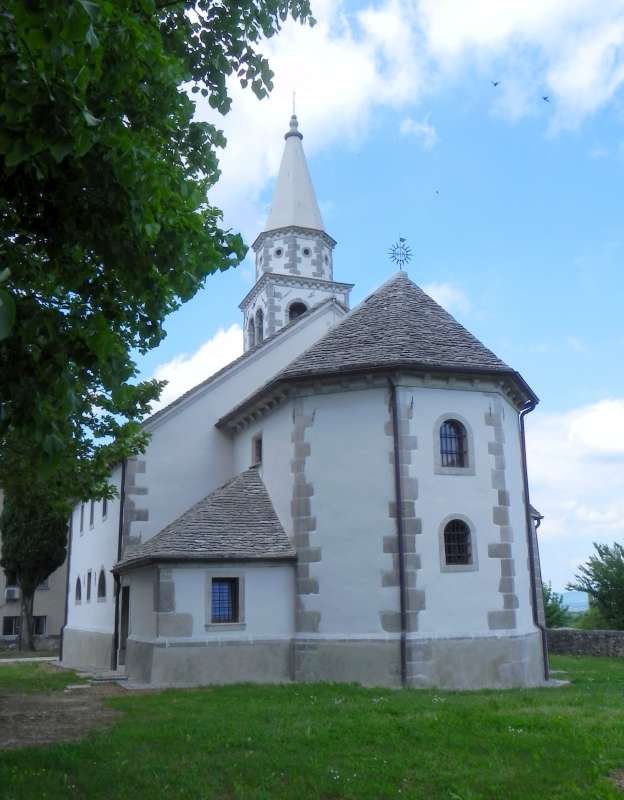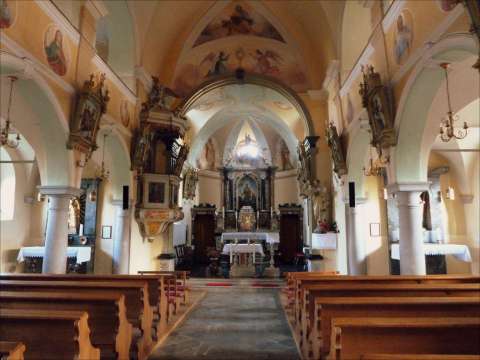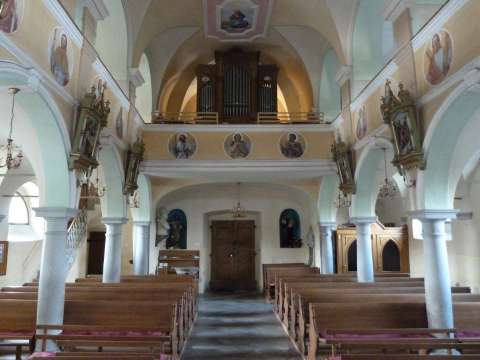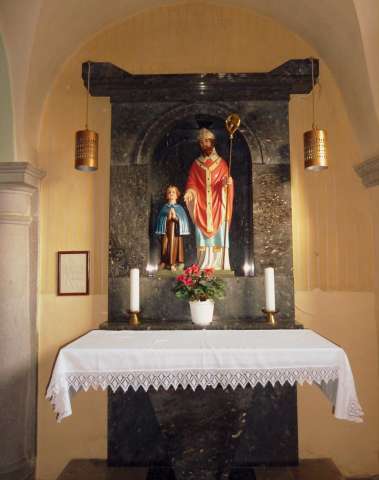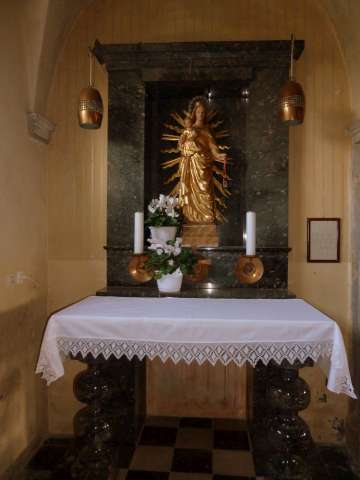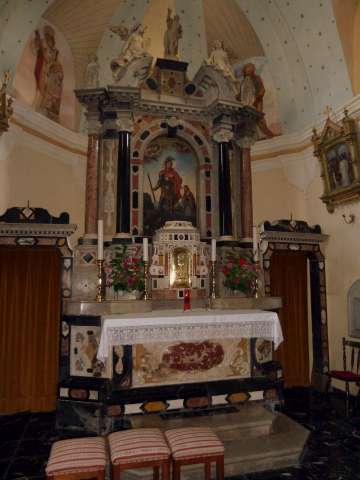
St. George church
The church in Dutovlje is dedicated to St. George – the Knight of Cappadocia and a martyr that was a Christian soldier.
The St. George church in Dutovlje was built in 1450 and sanctioned on 13 July 1450 by Bishop Enea Silvio Piccolomini from Trieste who later became Pope Pius II. At the right side of the main entrance, his bust can be seen.
The St. George church in Dutovlje was built in 1450 and sanctioned on 13 July 1450 by Bishop Enea Silvio Piccolomini from Trieste who later became Pope Pius II. At the right side of the main entrance, his bust can be seen.
|
In 1632, the church was renovated and in 1740, it was enlarged. Now it is decorated in the Renaissance style and represents the highest point in the village (313 m) with a nice view of individual villages towards Štanjel and the Trnovo Forest from the north-western corner. In the background, individual hills and mountains can be seen, such as Čaven, Krn and the Kanin Mountains. At the west side of the church, a typical belfry in the Aquila style was built in 1774, measuring 34 meters. This year is also carved on the belfry portal. Until 1820, the church had a wall and four corner towers for defence against the Turks. The south-east tower remained standing until the beginning of the 20th century.
The walls and old carved inscriptions, which were unfortunately not preserved, indicated the presence of the Knights Templar. This monastic military order from the 12th century had a fort here, protecting Christian pilgrims headed to the Holy Land. With time, their power and riches increased, leading to their prosecution in the 14th century. However, their legacy has survived to this day. The French king Philip IV issued the arrest order for all Knights Templar on Friday 13th, which is why this day is considered to be unlucky. Until 1851, a cemetery surrounded the church, but was then relocated to a new location where it is still used today. The church in Dutovlje is listed in the Register of Immovable Cultural Heritage and represents a great treasure in terms of history, documentation, space, landscape design, culture and education. In terms of cultural heritage protection, it is a high-quality example of Karst architecture with a stone roof and stonemasonry details. |
Columns divide the interior of the church into two aisles and a nave, with galleries above the aisles. The main Baroque altar is made of colourful marble and was built around 1700. It is dedicated to St. George who is painted with oil on canvas, with the painting dating back to 1877.
In the presbytery, we can find an altar and an ambon from marble parts of the former communal table. Both were set up in 1970. A portal from black marble from the 17th century with a beautifully carved door serves as the entrance to the sacristy. Along the arch on the left side, there is a late Baroque wooden pulpit from around 1770 with symbols of hope, faith and love.
The side altars from black stone were built in 1960. The right side altar is dedicated to St. Blaise and the left side altar has a wooden statue of the Carmelite Mother of God.
The side altars from black stone were built in 1960. The right side altar is dedicated to St. Blaise and the left side altar has a wooden statue of the Carmelite Mother of God.
On both walls and on the balustrade of the choir-loft, we can find medallion paintings for all twelve apostles, together with St. Cecilia. They are accompanied by neo-Romanesque framed wooden reliefs representing the Way of the Cross. The nave vault has paintings of St. Luke, St. George, Holy Trinity and St. Mark.
There are also statues of St. Joseph and St. Anthony of Padua at the main church entrance. Next to the entrance, there is a stone Renaissance basin for holy water with a coat-of-arms and the year of 1569.
On the choir-loft, there are mechanical pipe organs from 1896 that were built by Franc Goršič, a renowned pipe organ master.
There are also statues of St. Joseph and St. Anthony of Padua at the main church entrance. Next to the entrance, there is a stone Renaissance basin for holy water with a coat-of-arms and the year of 1569.
On the choir-loft, there are mechanical pipe organs from 1896 that were built by Franc Goršič, a renowned pipe organ master.
Sources:
http://sl.wikipedia.org/wiki/Sveti_Jurij, 29 September 2012
Albin KJUDER, Historical Mosaic of the Primorska Region, Sežana 1972
Slovene Church Lexicon, the Diocese of Koper, Dekanija Kraška 1, Celje 2004–2007
Miloš STANKOVIČ, With Bicycle Among the Karst Rocks, Dutovlje 2011
Photographs:
Mateja Štoka
Monika Rešetič
http://sl.wikipedia.org/wiki/Sveti_Jurij, 29 September 2012
Albin KJUDER, Historical Mosaic of the Primorska Region, Sežana 1972
Slovene Church Lexicon, the Diocese of Koper, Dekanija Kraška 1, Celje 2004–2007
Miloš STANKOVIČ, With Bicycle Among the Karst Rocks, Dutovlje 2011
Photographs:
Mateja Štoka
Monika Rešetič
